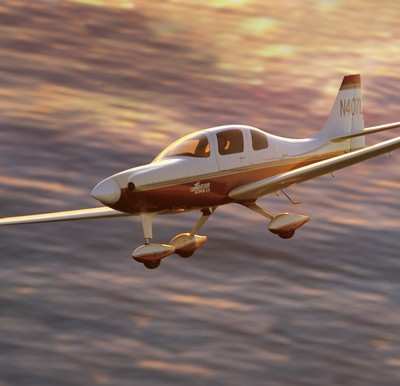Plane Encountered Icing Conditions, Three Lost
The National Transportation Safety Board said several factors
contributed to the downing of a plane near Albany, OR last
February, claiming the lives of all three persons on board.

The owner/pilot of the Lancair Super ES was seated in the left
seat, and a pilot friend of the owner in the right seat. Family
members indicated that friend and the owner/pilot flew together
often, and the right seat pilot would provide radio and navigation
assistance to the owner/pilot.
Although neither of the two pilots were instrument-rated,
according to information provided by the Seattle Air Route Traffic
Control Center, the pilot seated in the right seat had filed an IFR
flight plan earlier that morning.
The flight originated February 8 from McNary Field, Salem, OR at
1010 local time, and was headed for Klamath Falls Airport and then
on to Salt Lake City. The plane collided with terrain just minutes
later, approximately four miles northeast of Albany Municipal
Airport, near Albany, OR.
Numerous times during the evening prior and on the morning of
the fateful flight, both pilots checked weather forecasts along the
intended route. The forecast was for marginal VFR to VFR conditions
in the morning that were to improve by late morning, and there were
AIRMETS for icing, turbulence, and mountain obscuration.
At 1003, McNary Field weather conditions were reported as "wind
from 180 degrees at 14 knots, gusting to 19 knots, 10 statute miles
visibility, light rain, clouds were scattered at 2,900 feet, broken
at 3,500 feet, and overcast at 6,000 feet, temperature was 42
degrees Fahrenheit, dew point was 39 degrees Fahrenheit, and the
altimeter was 30.29 inches of Mercury."
In its official report on the incident, the NTSB narrative said
that following departure, a pilot from the accident airplane
contacted the Seattle ARTCC at 1006:58 and was cleared to climb to
13,000 feet msl.
At 1012:40 the controller advised the airplane there were
earlier reports of moderate icing between 10,000 and 12,000 feet
msl. A voice responded with the airplane call sign.
At 1013:20, the controller advised that the icing reports were
moderate-mixed icing. No response was received from the airplane
and the controller queried him at 1013:40. The airplane responded
at 1013:46 with the call sign.
At 1017:43 an occupant of the airplane contacted the controller
stating the airplane's call sign. At 1017:56 a transmission from
the airplane stated, "...ah niner bravo whiskey we have
(unintelligible) niner bravo whiskey."
The controller advised the airplane that the transmission was
not intelligible, and at 1018:05 a transmission for the airplane
reported, "...nine bravo whiskey we're an emergency situation niner
bravo whiskey emergency (unintelligible)." There were no further
transmissions from the accident airplane.
 The Lancair was equipped with a
Chelton navigation system, and the two display units were examined
at the NTSB Recorder Laboratory in Washington, DC.
The Lancair was equipped with a
Chelton navigation system, and the two display units were examined
at the NTSB Recorder Laboratory in Washington, DC.
Review of the data obtained from the units showed that the
accident flight power-on time was approximately 28 minutes. Through
most of the flight, the engine revolutions per minute (rpm) were
2,600 rpm, decreasing to 2,000 rpm at 1018:04, and 14 seconds later
the final reading showed 1,600 rpm.
During the last portion of the flight, the descent rates
increased to 10,000 feet per minute, and the indicated air speed
showed an increase from 100 knots to approximately 160 knots.
The last 45 seconds of data showed great fluctuations in the
recorded data and performance numbers for ground speed, heading,
track, rate of climb, pitch, bank, and vertical acceleration.
A witness about 2 miles west of the accident site saw the
airplane come out of a cloud layer about 2,000 feet above ground
level. With the right wing pitched down, the airplane was in a
clockwise corkscrew pattern, at a descent angle of approximately 45
degrees. It continued this corkscrew pattern until going out of
view of the witness.
The NTSB determined the probable cause of this accident to be
the pilot-in-command's failure to maintain aircraft control while
in cruise flight. Contributing factors to the accident were
inadequate planning/decision making, icing conditions, and
continued flight into known icing conditions.
According to FAA Advisory Circular (AC) 91-51A, "The most
hazardous aspect of structural icing is its aerodynamic effects.
Ice can alter the shape of an airfoil. This can cause control
problems, change the angle of attack at which the aircraft stalls,
and cause the aircraft to stall at a significantly higher airspeed.
Ice can reduce the amount of lift that an airfoil will produce and
increase drag several fold."
 ANN's Daily Aero-Linx (04.15.24)
ANN's Daily Aero-Linx (04.15.24) Classic Aero-TV: 'No Other Options' -- The Israeli Air Force's Danny Shapira
Classic Aero-TV: 'No Other Options' -- The Israeli Air Force's Danny Shapira Aero-News: Quote of the Day (04.15.24)
Aero-News: Quote of the Day (04.15.24) Airborne 04.16.24: RV Update, Affordable Flying Expo, Diamond Lil
Airborne 04.16.24: RV Update, Affordable Flying Expo, Diamond Lil ANN's Daily Aero-Term (04.16.24): Chart Supplement US
ANN's Daily Aero-Term (04.16.24): Chart Supplement US




